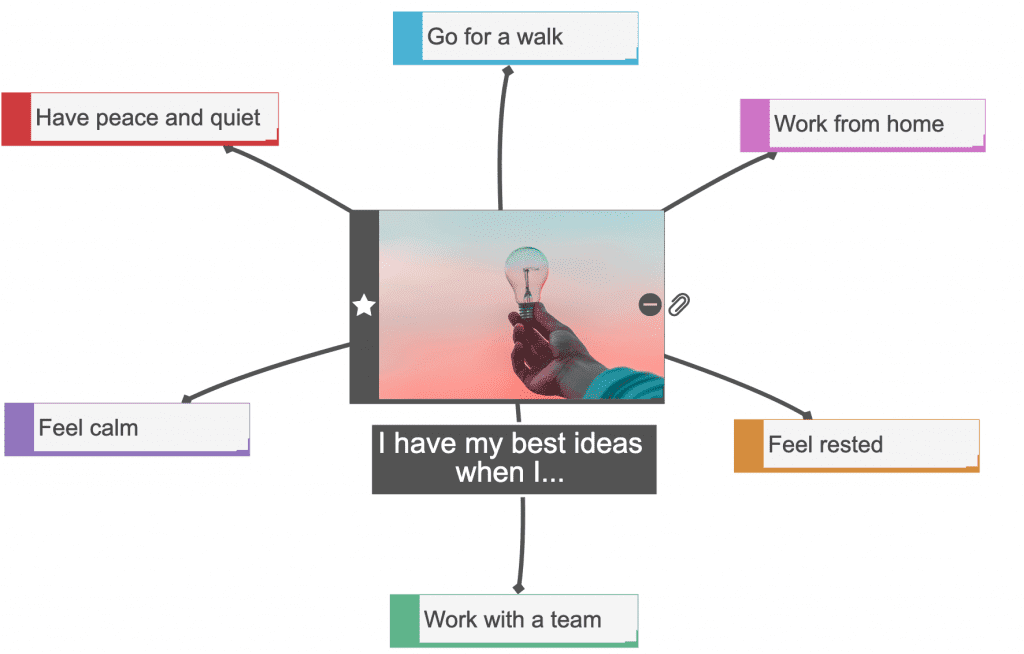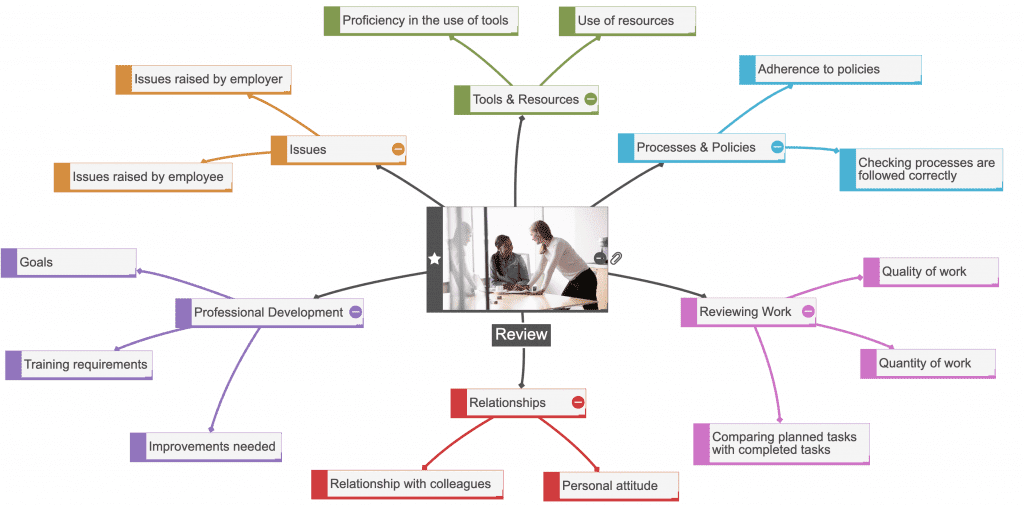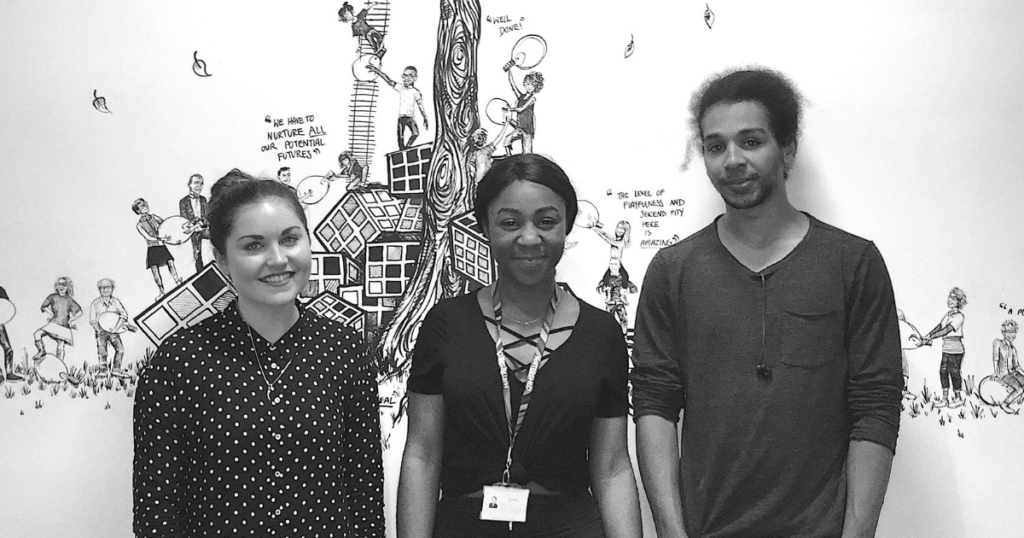Teaching mind mapping for business or education
Mind mapping is an incredibly useful technique for unlocking creativity. Getting a group, whether they’re colleagues or students, on board and using mind mapping efficiently can turn a project around. So, how do you get people started with mind mapping?
Master the art yourself first
To help people mind map effectively, you need to master the art yourself. This goes for hand-drawn mind mapping as well if you’re using a mind mapping software. Check out our blog post on how to make a mind map. Once you’ve become an expert at mind mapping yourself, you can branch out and help others understand the benefits of mind maps.
Get your group started
The best way to help people understand how much creativity can be unlocked with mind maps is to show them how it works. Start with a central idea and encourage everyone in your group to provide a comment or some input.
For example, “I have my best ideas when…”
Once you have agreed on your central idea, add two or three sub ideas of your own.
“…when I work at home,” for instance.
From there, ask for ideas from whoever you are working with. If you are using mind mapping software like Mind Map Pro to create an online mind map, each person could add ideas from their own screens or laptops remotely. The real-time collaboration function means all screens update live.

Explain why mind maps work
Congratulations, you’ve created a mind map!
This would be a great point to explain how mind maps work, by utilising lateral thinking rather than following linear processes, and explain why this is so effective.
Using mind maps to help information cross over both sides of your brain, covering the logical side and the creative side, you can access new ideas that you might not have conjured up with other techniques, such as making lists.
Mind mapping with colour and adding images when creating mind maps makes them more visually engaging, helps you understand more, improves memory and makes the task more enjoyable.
Give free reign or use templates
When you are teaching others a creativity technique like mind mapping, give them as much freedom as possible.
Encourage them to use space, colour and images however best suits them. The result could be a geometrically perfect design, or a mass of pictures and colours that don’t coordinate at all but leads to original thinking. The aim is to allow them creative flexibility which will inspire innovative thinking.
However, there are other options too. If you are working with people who have never used mind maps or don’t see their value yet, or if you have preconceived concepts you need to explore, it might be useful to start with a template.
You use mind map templates in Mind Map Pro, which has a variety of templates across 8 categories:
- Business
- Education
- Events
- Meetings
- Personal
- Sales and Marketing
- Software Development
- Team Templates for creating and saving your own!
These templates help you get started with mind mapping by providing an initial structure. Some have lots of branches and ideas, some are more minimal.
You can add ideas, delete ideas, move them around and add documents and images as much as you like, to make the mind map your own.
If your team is struggling to get started, this can be a great jump-off point. In the interest of creative thinking, encourage them to change the template as much as they want to.
Templates are there as a way to get started quickly, but there will be times when it’s best for people to start their own from scratch. You can choose either route using Mind Map Pro.
Mind mapping for learning differences
People have different ways of working and learning. Mind maps are a great way to help visual learners and can be substantially beneficial for people with dyslexia.
Dyslexia is a learning difficulty which can affect numeracy, literacy, memory, sequencing and concentration. It’s estimated that 1 out of every 10 people in the UK suffer with it to some degree, even if undiagnosed. Whatever team you are working with, there’s a good chance there is some neurodiversity in your group.
Mind maps can play a fundamental role in learning and understanding for people with dyslexia. Unlike a list, or a dense piece of text, mind maps have less words and a different layout. This makes it easier to process initially, and to remember later on.
Tagging these words to visual cues allows the brain to store the information across several areas, meaning it can be recalled later much more easily. Many online mind mapping software platforms allow you to upload your own pictures and set colours, either as you go or after you’ve entered all the information. You could even start with images and update the text later. On top of this, besides the initial idea, there is no right or wrong way to start mind mapping, so sequential thinking isn’t necessary.
Another benefit is the way information is broken down. Some people find reading long paragraphs more difficult than others. Many people read in a way that skips some words, with their eyes dancing around the text, whilst still understanding the overall context. People with dyslexia find that much more difficult. Each word takes longer to process so reading can be laborious and dull.
By breaking information into manageable chunks and visual categories in a mind map, the process of reading and interpreting information isn’t forced into a linear sequence, giving the brain space to hop around to the most interesting parts, without the mind map losing meaning.
Mind mapping has been shown to have such a strong impact on the learning of those with dyslexia that many colleges and universities purchase subscriptions for mind mapping software on the behalf of their students.
Specialist support staff are trained on how to teach students to use mind maps effectively for everything from note taking and revising to planning essays and presentations.
That doesn’t mean you need to be a specialist to teach someone how to mind map, though. By helping your team understand the benefits, and giving them the freedom to explore, anyone can unlock their mind mapping potential.
Mind mapping for mathematics
It might seem as though mind mapping is better suited to more typically creative industries, or specific subject areas within education, but mind maps have far more potential applications.
Mind mapping is a great way to problem solve. You can think in a different direction and apply knowledge to new concepts.
Considering this, mind maps fit very comfortably within any profession which relies on mathematics. Combining all the knowledge from various areas of your brain and applying them to one problem can be a difficult task. Opening up your way of thinking by using a mind map helps you look at things from a new perspective.
Mind maps can help you examine a problem, break it down and understand where to go next. With Mind Map Pro, you can store your standard mathematical thinking within the notes section of each idea or by attaching a document. You could go into as much detail as you need, or just keep to the basics and explore your options.
Some mathematicians have even described mind maps as a recipe book for applying new ways of solving problems. Thinking about it like that, you can use a mind map to break down each possible approach you could take and explore how you would apply them to each section of the problem.
Mind mapping can also expose gaps in your knowledge. Mathematical problems require you to draw connections between values and ideas. In a mind map, you can actually draw these connections.
If you are struggling to find connections that make sense, it could be that the method you are using is wrong, or that you have a mistake somewhere in your work. Studying problems in a visual way by mind mapping can expand your thinking and allow you to reach new insights in almost every industry and subject.
Mind mapping for reviews
For every business, analysis, assessment and reflection are important for growth. Teaching your team how to mind map and utilising the process of mind mapping for reviewing knowledge or performance could give you more insights than an unstructured, or traditional, meeting.
Taking a three-month review as an example, by providing a mind map template using a mind mapping software, or creating an online mind map, performance reviews could be based around key topics prior to your meeting. You could split this down into points such as:
- Reviewing Work
- Quality, quantity and comparing planned tasks with completed tasks
- Processes & Policies
- Checking processes and policies are followed correctly
- Tools & Resources
- Proficiency in the use of tools or resources
- Relationships
- Personal attitude and relationship with colleagues
- Issues
- Issues raised by employer or by employee
- Professional Development
- Goals, training requirements, improvements needed

By completing this review as a mind map, you encourage all parties to become more creative with their answers. Issues and ideas may come to the surface, which perhaps would not have if the format was a traditional box-filling exercise.
If you are creating an online mind map for your review, you can even input answers before your meeting. During the meeting, you can collaborate further to edit and expand the mind map as much as is needed. Colour coding could show which answers your employee or student has input, and which ones you decided upon together.
You can export the mind map to produce an engaging resource to take away, encouraging your student or employee to keep working forward. If you use Mind Map Pro, you can also use the task board to decide on a plan of action and allocate tasks.
For a project review, setting up a collaborative mind map for your team provides them with a space to reflect on what went well and what could be improved on. If you used an online mind map or mind mapping software to manage this project initially, you could simply add a new idea and branch out from there, or you could set up a whole new mind map to go into more detail.
It has been well documented that evaluating performance as a team gives space for reward and recognition, as well as an opportunity to set agreed goals for future projects.
Employees or students will feel appreciated and refocused moving forward, which is essential for growth. Using a mind map ensures that everyone has a voice, no matter how they process information or express themselves, and are more likely to come up with creative solutions for the future.
Next up, browse through our Help Site for guides on using Mind Map Pro.



